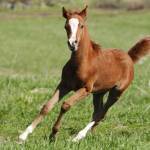Nature Versus Nurture: Factors that Affect Growth of Horses

Large, well-grown horses are the desired mounts in many equine disciplines. Because birth weight influences mature body weight in some breeds, breeders aim to produce heavy foals at birth. A foal’s birth weight is about 10% of mature body weight, but this can vary from about 7% of mature weight in draft breeds and up to 14% of mature weight in small ponies such as Shetlands. What is remarkable is that at birth, foals have only achieved 17% of mature bone mineral content and don’t reach mature bone mineral content until six years of age.
Several management practices are used by breeders to increase the chances of a heavy foal. These include supplementary feeding of mares during pregnancy and selecting for large mares. Because birth weight of the foal is on average 10% of mare body weight, larger mares tend to deliver larger foals.
Mare age and number of foals she has had in the past have also been shown to affect foal size. Mares between the ages of 7 and 11 have foals of heavier birth weight and foals born to maiden mares have lower birth weights than those who have had foals in the past. Foals with higher birth weights are generally heavier throughout life, and there is some evidence that Thoroughbreds with low birth weight (<88 pounds, 40 kilograms) were less likely to race and have inferior racing performance characteristics compared to heavier foals.
Rapid growth occurs during the first year of life. At six months of age foals are about 40% of mature weight and 80% of mature height, and by 12 months of age foals have reached about 60% of mature weight and 90% of mature height. By 24 months of age horses have reached 96% of mature weight and nearly reached mature height.
Horses generally show a similar pattern of growth between birth and 18 months of age. The most rapid growth occurs in the first month of life with daily weight gain declining over the next 11 months of age. In temperate climates, the observed lowest point in growth rate around 10-11 months of age coincides with the winter months of decreased pasture quality and availability. Around 12-14 months of age, weight gain increases in conjunction with a usual spring pasture flush, onset of puberty and sometimes preparation for early season sales. Breed has an influence on growth patterns with ponies maturing faster than larger horses. Smaller breeds reach a greater proportion of their mature weight or height at a younger age than do larger breeds that keep growing for a longer time period.
Birth month and birth season have a significant effect on growth rate as foals born in the winter are generally smaller than those born later in the season. A study of 3,909 Thoroughbred mares and their foals in Kentucky has shown that winter-born foals (those born in January and February) were smaller at birth and grew slower during the first two months compared with spring-born foals.
These winter-born foals then exhibited rapid daily weight gain at three months of age, coinciding with a spring pasture flush. This compensatory growth resulted in there being no difference in body weights between foals born in any birth month at five months of age. Later-born foals (those born in May and June) exhibited the lowest daily weight gains at two, three, and four months, which coincides with late summer pasture losing its quality, suggesting a definite seasonal effect on foal weight gain.
Interestingly, mare body weight and condition had a strong effect on foal growth as foal body weight was positively correlated to mare body weight, foal ADG (average daily gain) was positively associated with mare ADG, and foal fatness (indicated by body condition score or BCS) was positively related to mare BCS during the first five months of life. These relationships indicate that heavier mares produce heavier foals, faster growing foals are from mares that are gaining weight, and fatter foals (those with higher BCS) are produced from fatter mares. In addition, there was a positive relationship between foal BCS and mare daily weight change at two and three months (peak lactation), indicating mares that are gaining weight during the first three months of lactation have fatter foals.
Regardless of birth month, mares that exhibited a negative energy balance postpartum (losing weight or negative daily weight change) had foals that did not gain as much weight as mares that were in a positive energy balance at any time between birth and five months postpartum. January- and February-foaling mares tended to lose weight in early lactation, suggesting that their caloric intake is insufficient to meet their energy requirements for early lactation. Later in lactation when the climate was warmer and there was access to adequate pasture, these early-foaling mares gained more weight and supported faster growth rates in their foals than later-foaling mares.








